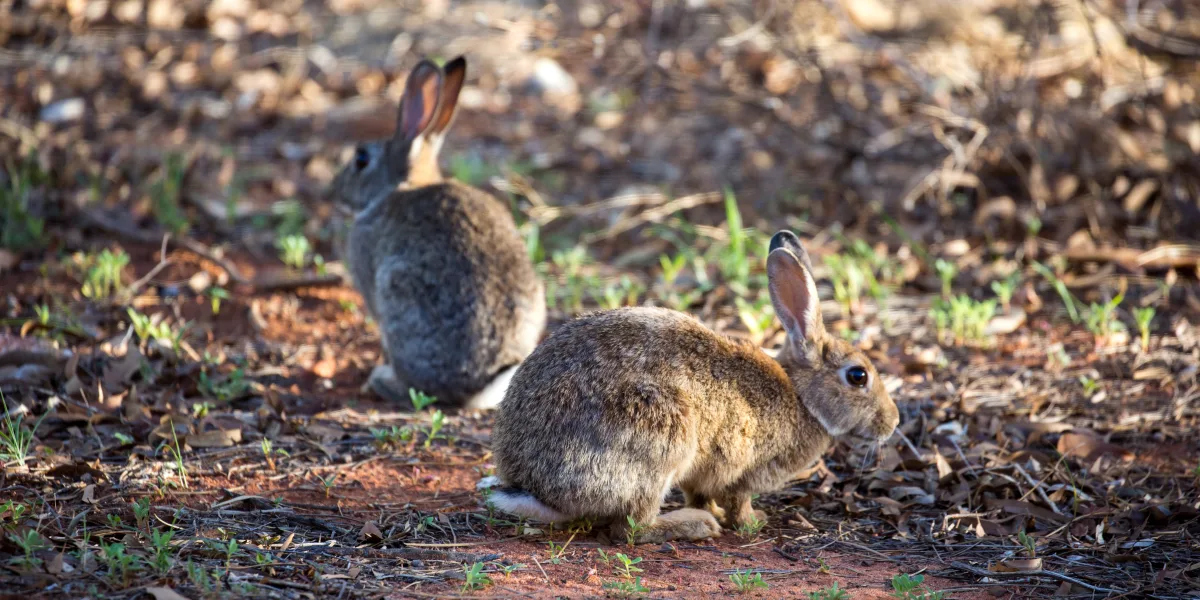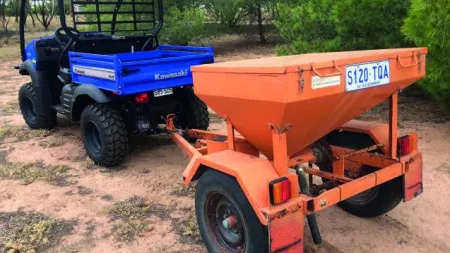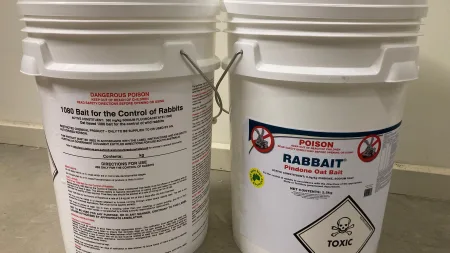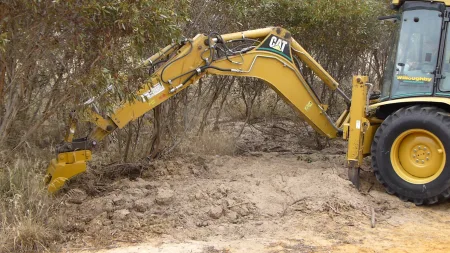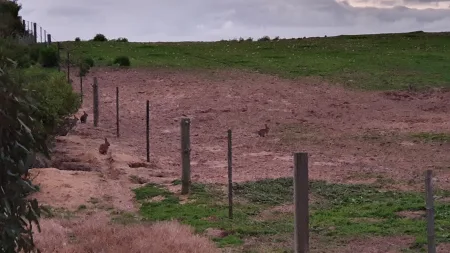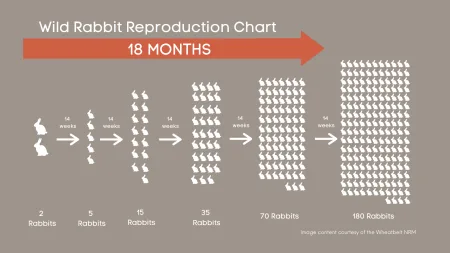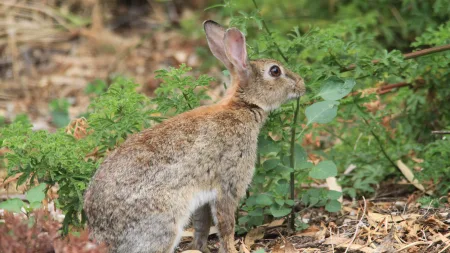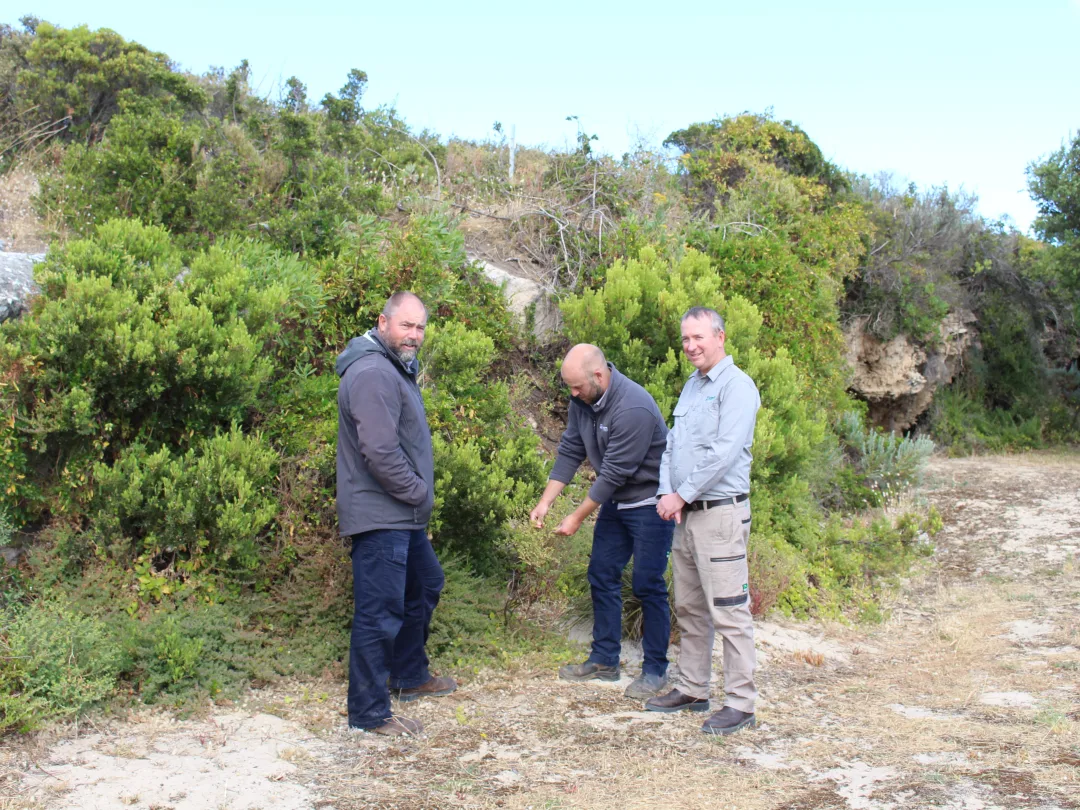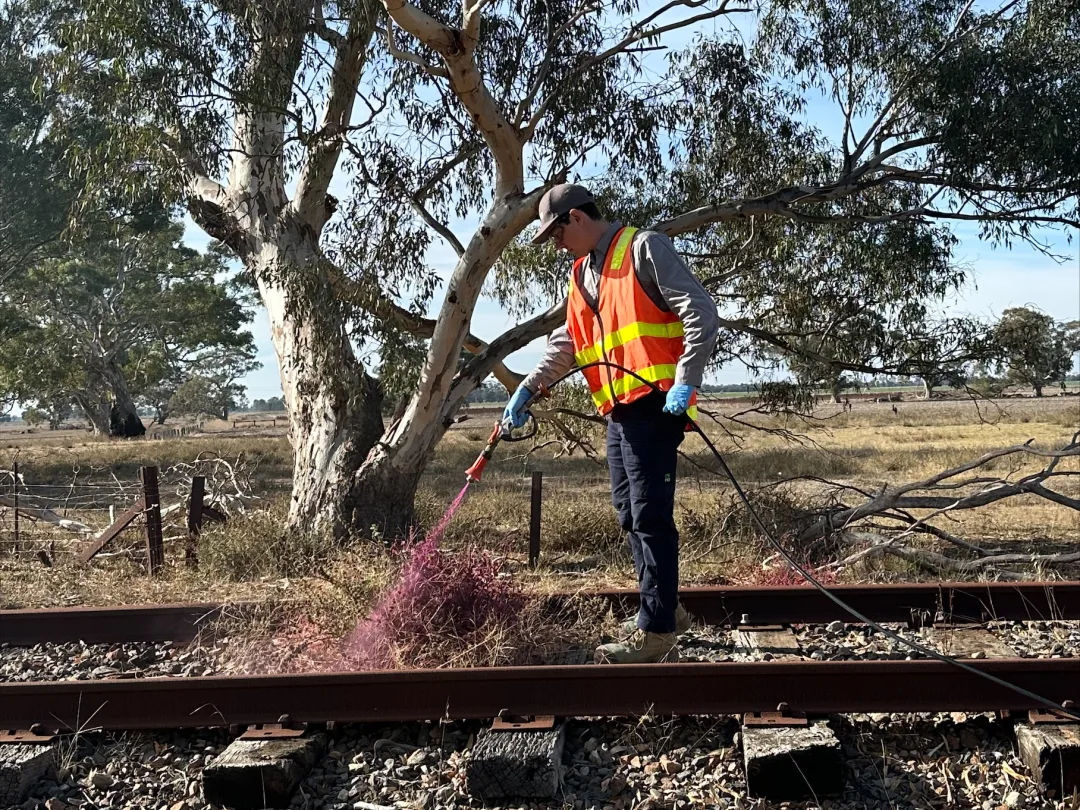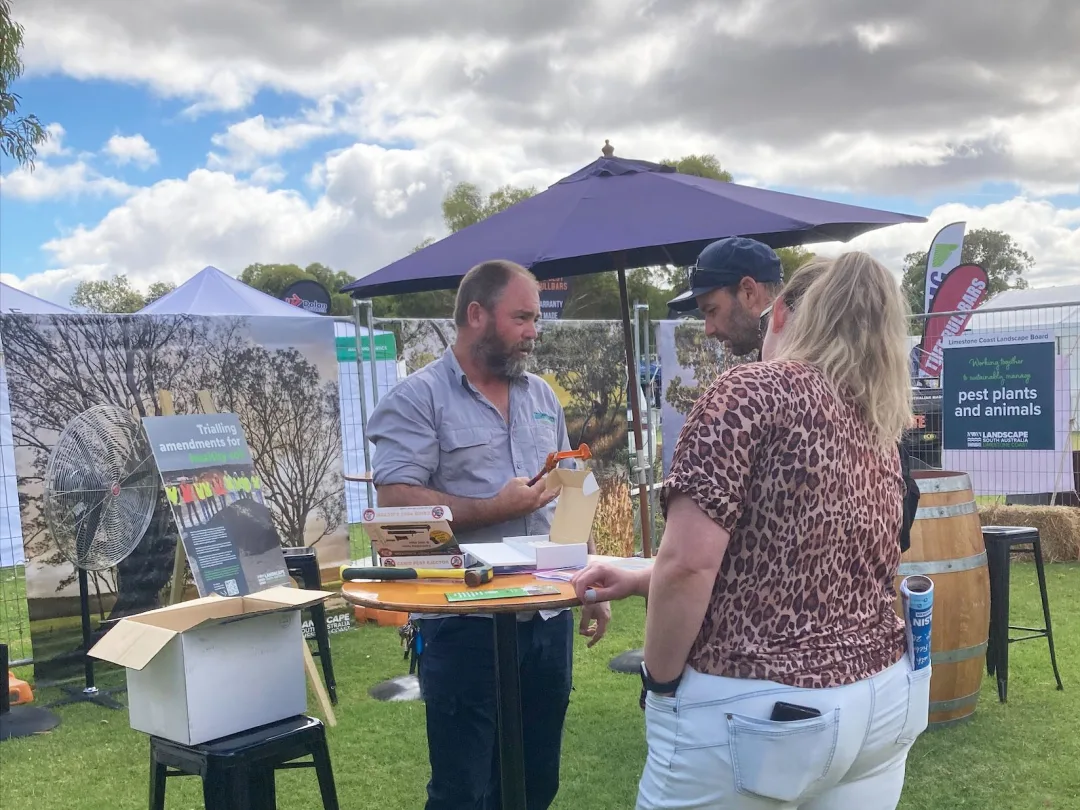The benefits of controlling rabbits on your property
Controlling wild rabbit populations on your property can provide many benefits.
Protect your agricultural productivity and profitability
Rabbits are notorious for damaging pasture and crops. This can have significant economic impacts on farmers. By maintaining pressure on rabbit populations, you can protect your crops and increase feed available for your livestock.
Prevent soil erosion
Overgrazing of vegetation by rabbits can create bare ground and lead to soil erosion from wind and rain. This degrades soil quality and reduces its ability to support plant growth. Rabbit control helps maintain vegetation cover to protect your soil.
Protection of infrastructure and farm safety
Rabbit burrowing can damage infrastructure such as roads, railways, and buildings. Rabbit burrowing can also create a safety hazard under hay sheds and can cause collapse. Burrows in paddocks pose a hazard to livestock or vehicles. Controlling rabbits improves farm safety, and reduces infrastructure damage, saving repair costs.
Preservation of the native environment
Rabbits can wreak havoc on the native environment by overgrazing. They can selectively graze on vulnerable species such as seedlings and native orchids. This can cause the complete failure of revegetation projects. Controlling rabbit populations each year reduces food resources for foxes and feral cats and helps to protect remnant native vegetation and wildlife habitat.
According to CSIRO, due to their selective grazing habits, less than one rabbit per hectare can completely prevent the regeneration of certain native tree and shrub species that are palatable to rabbits.
Finding the right rabbit control method for your property
Effective rabbit control reduces rabbit numbers through baiting, destroying warrens and removing harbour. Follow-up control of re-invasions such as with biocontrol is also critical.
If you are not familiar with identifying the presence of rabbits, signs to look out for are warrens or aboveground cover that may harbour them. Also look for where rabbits have been active, such as burrows, fresh scratches in the soil, bare ground or clusters of dung and damage to vegetation.
Preparing for rabbit control on your property
Talk to your neighbours for more effective and coordinated rabbit control
Rabbits do not recognise property boundaries. Teaming up with your neighbours to put in place a coordinated program using many methods will have a much greater result. It can reduce both the rabbit population and level of reinvasion.
Getting the best results
For the best results, you should think about timing, consistency and coordination when planning your control program. Your location, land size and proximity to neighbours will determine the most suitable rabbit control methods for you.
Rabbits are territorial and generally don’t travel more than 200 m from their home. Your control program will need to be focused on the warren/shelter plus the estimated total area the rabbits move.
Our Landscape Officers can support your control efforts through assisting to coordinate neighbourhood control programs, supplying bait, biological control agents, hiring equipment and much more.
The best approach is multiple methods with follow-up control
The best rabbit control is achieved through an integrated approach that uses a variety of rabbit control methods. The important first step is to reduce rabbit numbers by undertaking trail baiting using options such as 1080 oat bait, Pindone oat or carrot bait. The next step is to destroy warrens and remove rabbit harbour, often done by fumigation or ripping of warrens. Follow-up control is essential. It can include:
- releasing biological control agents (calici-virus)
- ground shooting or trapping
- preventing re-incursion by building exclusion fencing around hay sheds or firewood stacks.
Rabbit control programs should be long-term. Applying diverse control methods often will produce great results and restrict the rapid recovery of rabbit populations.
The timing of your control is important
Control methods must be applied at the right time to be effective.
Mid to late summer is the best time to undertake rabbit baiting programs as food resources are limited and rabbit numbers are at their lowest. Rabbits are more easily trained to take bait when food is scarce. Rabbits breed with the onset of green feed. Baiting in late summer or early autumn can interrupt the breeding cycle and achieve better long term results.
Early autumn is the best time to remove harbour as the soils are dry this will make it easier for you to collapse burrows.
Winter is the best time to build exclusion fencing to prevent reinvasion.
The Rabbit Haemorrhagic Disease Virus (RHDV) K5 strain (also known as calici-virus) is the latest available biological control. To help achieve long term benefits from RHDV K5 it is best to expose as many adult rabbits as possible when flies are active and can help spread the virus. Avoid releasing the virus when rabbits are less than 12 weeks old as this can lead to immunity to the virus.
Baiting for the most effective control results
With calici virus losing effectiveness, baiting is the cheapest and most effective large-scale tool available for controlling rabbits on your property. You can achieve the best results with coordinated, large-scale neighbourhood baiting programs. Plan your baiting program early as in some cases there is an approval process to complete before baiting can start.
Bait types and how to access them
Sodium fluoroacetate (1080) and pindone are the two main chemicals used for rabbit control. 1080 is a regulated chemical with strict conditions of use.
Domestic dogs and other non-target animals may die as a result of consuming rabbit bait.
You must read and follow all instructions and safety information for your baits (including uneaten and unused). When used in accordance with the directions for use, risk to non-target animals is far reduced.
We provide the signs when distributing the baits.
| Pindone | Pindone | 1080 |
|---|
Bait substrate | Oats | Carrots | Oats |
Available from | Limestone Coast Landscape Board and rural/hardware suppliers | Limestone Coast Landscape Board | Limestone Coast Landscape Board |
Minimum property size | 1,000 m2 | 1,000 m2 | 5 hectares |
Distance restrictions apply | No | No | Yes |
Approved for urban settings/ townships | Yes | Yes | No |
Mandatory neighbour notification | No | No | Yes |
Signage required | Yes | Yes | Yes |
Antidote available | Yes | Yes | No |
Collection of baits can be organised through our Landscape Officers. Contact your local Landscape Officer to order your baits and arrange collection. Collection locations occur in Millicent, Mount Gambier, Penola, Kingston, Naracoorte and Keith. Collection depots are not always open, ensure you call ahead.
If you are purchasing 1080 bait to use on your property, when you collect the bait you will need to sign an Approval to Possess form. If you cannot collect your baits in person or are not the person who will do the baiting on your property, you must nominate an agent and fill out an Approval for Nominated Agent to Collect form. The agent must bring this completed form with them to collect the baits.
Approval for Nominated Agent to Collect form [PDF, 101 KB]
Contact your local Landscape Officer to order your baits and organise collection
Prices and quantities can be found on our price list
How to use baits for controlling rabbits
For all rabbit
baiting programs, ‘free feeds’ are laid a few days apart followed by the
‘poison feed/s’. Free feeds are important to ensure the rabbits are used to
consuming the bait when it is laid with poison.
The location
of bait trails should be selected based on areas where rabbits are actively
scratching/feeding, but not directly around warren entrances. Rabbits can be
wary of changes close to their burrows, and typically feed further out. Rabbits
will feed mostly within 25 to 50 m of their warren.
Rabbits are
territorial and will investigate freshly disturbed soil. For best results when
baiting, it helps to scrape a shallow furrow using a bait laying machine,
plough, grader blade or by dragging a hoe or mattock across the ground.
1080 Treated oats:
- available from the Limestone Coast Landscape Board
- 3 mandatory free feeds prior to poison feeds
- free feed interval: 3 days
- 1 mandatory poison feed required.
Pindone Treated oats and carrots:
- available from selected agriculture suppliers and the Limestone Coast Landscape Board
- 1 - 2 free feeds prior to poison feeds
- free feed interval: 3 - 5 days
- 3 poison feeds required
- poison feed interval: 3 - 5 days.
Controlling rabbits in urban or semi-urban areas
Controlling rabbits in urban areas can be difficult as the range of options available is more limited than rural areas. If you live in an urban area, please chat to your local Landscape Officer to discuss the right control for your circumstances.
Currently, pindone is the only poison bait available in urban situations for rabbit control. Your property must be 1,000 m² or larger and you must follow label instructions for urban areas.
When used in accordance with the directions for use, risk of pindone to non-target animals is far reduced. If pindone poisoning of domestic animals occurs, treatment from a vet can be successful.
In urban situations we recommend that fumigation of warrens is only done by a suitably qualified person or contractor.
Removing shelter so rabbits can’t hide
Rabbits look for a sheltered place that provides protection from predators and is a safe environment to breed. They will either build warrens underground, or shelter aboveground under thick vegetation or other materials.
You should remove materials, such as wood, bricks and hard rubbish where possible. If you can't remove them stack them at least 50 cm above the ground and in such a way that there are no cavities for rabbits to enter.
Warren ripping for long lasting rabbit control
Follow your baiting program with warren destruction to achieve effective long term control.
Thorough warren ripping is the best way to destroy warrens, burrows and holes. Ripping of warrens is best undertaken following a baiting program. Contact Dial Before You Dig to check for underground cables, pipes and other services before carrying out ripping.
Warren ripping steps:
- Begin ripping the ground around 3 m outside the outermost rabbit hole.
- Use ripping tines that are at least 90 cm long.
- Rip a series of parallel lines across the warren area, spacing them about 40 cm apart. This disturbs the soil and collapses the tunnels, making the area less hospitable for rabbits.
- If you're not using ripping tines with winged boots or if the soil is heavy, consider making another set of parallel lines perpendicular to the first set (cross ripping). This ensures thorough disruption of the tunnels.
A warren can also be destroyed by collapsing it in on itself with earthmoving machinery or hand tools, and then filling and levelling the area.
Rubbish, stumps, and other cover need to be pushed off warrens and disposed of. This may not be possible if the burrow is located under something like a concrete slab or under native vegetation. In this case you should block the entrance to the warren with material that will prevent rabbits from reopening it. If you think your situation requires native vegetation clearance you may require approval.
Re-check warrens on a monthly basis and treat any reopened holes with a fumigant to keep them closed.
Visit the Department for Environment for further information on the requirements for native vegetation clearance
Other methods to support your control program
Fumigation of warrens
Follow your baiting program with fumigation to achieve effective long term control. If a rabbit warren can be easily accessed, fumigation may be an option for your situation. Fumigation is ideal when warrens are in hard to access areas such as steep banks, along fence lines or under.
Fumigation can be used to treat rabbit infestations where poison cannot be used or where ripping is not practical.
Fumigation will only control rabbits present in the burrow at the time of fumigation and is most effective in late summer or autumn.
Biological control
There are two types of rabbit biological control agents present in Australia: Myxomatosis and Rabbit Haemorrhagic Disease (also known as RHDV, K5 and calici-virus). Their effectiveness varies considerably from year to year as they are dependent upon a range of environmental factors.
There are no consistently reliable methods which can be used to accurately predict the timing or impact of Myxomatosis or RHDV on rabbit populations.
Reliance on biological controls alone will not bring populations down to long term sustainable levels. But biological controls can support landholder efforts to remove wild rabbit populations on their property.
Landholders interested in releasing a biological control are advised to contact their local Landscape Officer. They can support you with advice and supply of a biological control, equipment hire and assistance to organise a cooperative neighbourhood pest control program.
Rabbit biological control options have constantly improved over the years. The RHDV K5 variant is considered to have greater benefits for cool-wet regions like the Limestone Coast and, is safe for people, wildlife, livestock and pets (except domestic rabbits).
RHDV strains can infect domestic (pet) rabbits as they are descendants of wild rabbits. Pet rabbit owners are advised to vaccinate their domestic rabbits against the virus.
Shooting
Ground shooting to remove rabbits on your property can complement other control methods.
Although shooting may be useful when rabbit numbers are low it is labour intensive and is not as effective as other control methods.
Shooting can be a humane method of destroying rabbits when it is carried out by experienced, skilled and responsible shooters. It should be done in accordance with the Centre for Invasive Species Solutions National Code of Practice for the humane control of rabbits.
Read the National Code of Practice for the humane control of rabbits
Local Landscape Officers, local knowledge
We have a responsibility to ensure rabbits are effectively managed across the region. This is guided by the Limestone Coast Pest Plant and Animal Strategy.
Our Landscape Officers are spread across the region and can help you control rabbits on your property by providing:
- local advice on control methods and timing of control
- supply of rabbit bait and equipment
- help to coordinate pest control with your neighbours
- support for you to engage a private contractor to control rabbits on your property or engage our Weed and Pest Animal Control Service if doing the control work yourself is not practical.
To find the best rabbit control solution to suit your needs contact your local Landscape Officer by calling 08 8429 7550 or find your local Landscape Officer.
Find your local Landscape Officer
Read the Pest Plant and Animal Strategy today [PDF, 1 MB]
Understanding your responsibilities
In the Limestone Coast, rabbits are declared for control under the Landscape South Australia Act 2019 (the Act). There are separate declarations for wild rabbits and domestic rabbits.
Under the Act, you are responsible for the control of wild rabbits on your property. You cannot move, sell, keep or release wild rabbits.
Controlling rabbits on roadsides
The Limestone Coast Landscape Board is responsible for controlling declared pest plants and animals on roadsides. You may prefer to control rabbits on roadsides adjoining your property yourself. If doing so you must obtain appropriate authorisation from relevant authorities and comply with other regulatory requirements prior to commencing works.
When working on roadsides you must take all reasonable steps to ensure native vegetation is protected.
Read more about how we are controlling weeds and pest animals on roadsides
Recording rabbit activity in RabbitScan
RabbitScan is a free resource for landholders, Landcare and community groups, local councils, professional pest controllers and biosecurity groups. It has been designed by landholders for communities and is very easy to use.
What to record:
- Rabbit activity (such as sightings and warrens).
- Damage, such as soil erosion.
- Control activities (such as warren ripping).
- Disease in rabbit populations (such as RHDV).
Visit RabbitScan
